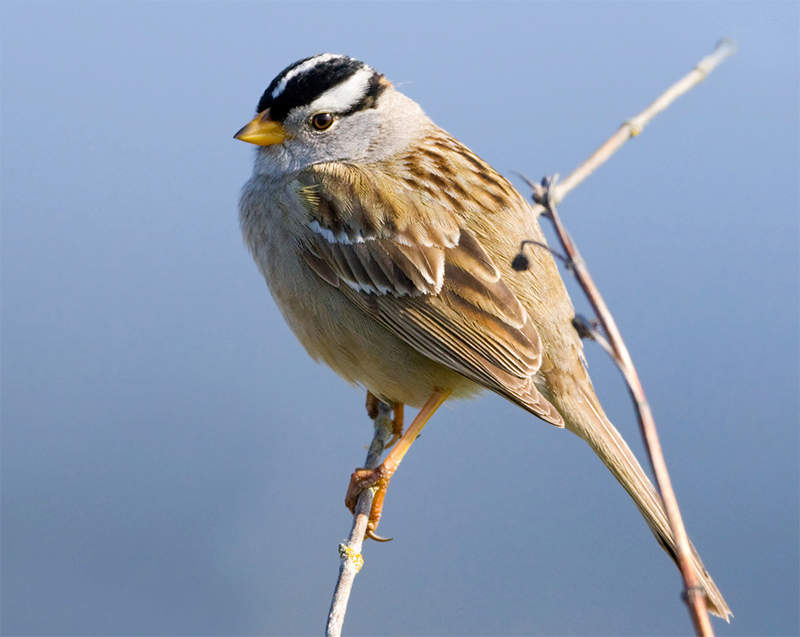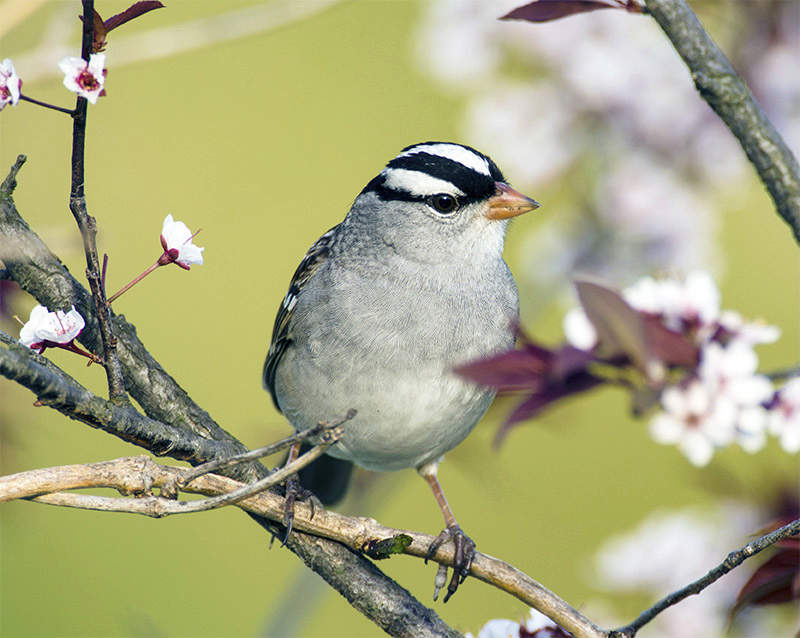Featured Birds: White-crowned Sparrows
White-crowned Sparrows can be found just about anywhere in America in late summer, and will remain over much of the Lower 48 through winter. They feed more on the ground than in feeders, so wise birders scatter a bit of white millet and/or sunflower on the ground near shrubbery or a brush pile to attract them where they can safely duck for cover if a predator appears.
In backyards, most of our sparrows stay close to shrubs or a brush pile, but White-crowned Sparrows often wander well out into a lawn, making them easier for us to detect. In natural habitats, White-crowned Sparrows are more often found in fields and edges than in forests. They feed by “double-hopping,” hopping backward on both feet, to turn over leaves, and then immediately forward to pick up anything that backward hop may have exposed. Towhees feed this way, too.

The White-crowned Sparrow’s seed-eating habits make it one of the easier species to keep in captivity. As a protected species, it’s of course illegal to keep it as a pet, but scientists with special research permits have made it the subject of a wide variety of scientific studies. For example, scientists interested in movement and energetics have discovered that White-crowned Sparrows can run on a treadmill at a pace of about one-third of a mile per hour without tiring out.
Those interested in how birds learn their songs have discovered that White-crowned Sparrows have a sensitive learning period when they are 10 to 50 days old. During this time, they pick up the song patterns from any White-crowned Sparrow songs they are exposed to; they will keep these song patterns throughout their lifetime regardless of exposure to different dialects.
Feeding on seeds makes White-crowned Sparrows easy to capture, and recapture years later, for banding studies, too. One banded White-crowned Sparrow was tracked moving 300 miles in a single night. In one of the most famous studies of a migratory species, 411 White-crowned and closely related Golden-crowned Sparrows were captured, banded, and flown in an airplane from San Jose, California, to Baton Rouge, Louisiana; 26 were recaptured at the California banding station the following year.
The next year, 660 birds were trapped and banded, using color bands as well as numbered aluminum bands, and transported all the way across the continent from San Jose to Laurel, Maryland. The colored bands helped people notice which birds stuck around and which disappeared; the birds hatched the previous summer tended to remain in Maryland through the winter while adults disappeared almost immediately. One young White-crowned Sparrow remained in Laurel until spring, and was recaptured back in Laurel the following fall, but no one knows where it spent the summer. And 15 of the birds returned to San Jose the following winter. Of these, six were among the birds that had already made it back there from Louisiana the previous year!

Studying wild White-crowned Sparrows without interfering with their day-to-day lives has also taught us important things. As in many species, male White-crowned Sparrows do most of the singing, but females also sing. The female song is quieter and more variable than the male’s, usually given when fighting over a nesting territory or a winter feeding source.
White-crowned Sparrows don’t particularly mind sharing a territory with Fox Sparrows but chase away Chipping Sparrows and Dark-eyed Juncos. To help the White-crowned Sparrows visiting your yard, make sure you keep your feeders clean, rake up the area beneath your feeders and areas of the ground where you scatter millet after wet spells to prevent seeds from getting moldy. Make sure no neighborhood cats can get into your yard—ground-feeding birds are among the most vulnerable to cats. And make your windows bird safe.




